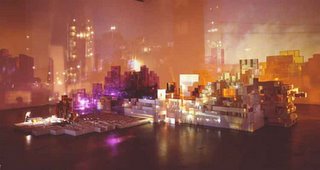Won Ju Lim: illuminated projections






http://artnet.com/artwork/424172585/won-ju-lim-memory-palace-baroque--2.html
http://www.pilarparra.com/artistas/won_ju/2.htm
http://www.artnews.info/artist.php?i=575
An MFA graduate of Art Center College of Design in Pasadena, Won Ju Lim currently lives and works in Los Angeles as a sculptor and installation artist. Taschen’s Art Now: 137 Artists at the Rise of the New Millennium finds that Lim’s work “focuses on the tensions between perception, space, and subjectivity in the post-modern age. In order to reflect on and represent the shifting relationship between these three elements, she usually takes architectural reconstructions whose ‘realism’ she questions, critically and poetically, through the judicious use of light, slide projection and video installation.”http://www.pilarparra.com/artistas/won_ju/2.htm
http://www.artnews.info/artist.php?i=575
She is best known for her installations of illuminated clusters of Plexiglas and foamcore, recalling architectural and industrial landscapes. Won Ju's work investigates fantasy, materiality, modeling, and illusion. These new pieces make good on what Lim's past installations have striven for: wonderful and uncomfortable overlays and slippages of present and past, presence and absence, and the strange commingling of memory, fantasy, physicality, modeling, and illusion. They harness illumination, distortion, projection, and shadow as method and metaphor, leaving their viewers standing in the light and in the dark.
Won Ju Lim is known for groupings of foamcore and Plexiglas architectural forms illuminated by still and moving projections of urban and industrial landscapes from within and dramatically lit from without. The structures double as screens or refraction lenses, creating shadows and distorting the projections as they hit the walls of the gallery. Lim's second show at this gallery offered a departure in a group of mostly rectangular light/shadow boxes (all works 2003) twenty inches deep and ranging in size from roughly three feet square to nearly four by eight feet. Hung at picture height in a darkened room, the boxes negate their own clunkiness and turn into hazy, glowing paintings that evoke hilly, home-dotted views of Los Angeles's Highland Park.
Those familiar with Lim's work might see this new project as a strategic streamlining of her more unwieldy earlier installations into manageable, consumable objects. There's no doubt the elements making up Terrace 49 have a decorative appeal; they even elicit a momentary flashback to novelty lamps and look-it-glows items for the home. The "packaging" is in fact a kind of concentration, an intensification of the viewer's experience, as Lim harnesses the elements that in past installations have tended to dissipate and raises effects that might have come off as merely nifty to the level of wonder.
Lovely and haunting, these works exploit associations with forms ancient and recent by which we entertain fantasies and memories, hopes and fears--all forms of projection, puppet theater, the shadows on the window shade at night, as well as painting, particularly Asian landscapes and Baroque and Romantic scenes. Part of a larger project the artist refers to as "Memory Palace," the pieces evoke the centuries-old mnemonic device from which her investigations take their name (as you move mentally through a chosen architecture, each room triggers the information you've assigned to it). But one need nor be familiar with the ancient method of committing speeches or literature to memory to find oneself moving through those land/ cityscapes trying to unlock meanings and memories and constantly gauging their tone and implications. Elegant as they are, the Terrace 49 pieces leave one unsure whether their scenes are calm or catastrophic: They're as close to one's recall of an amazing sunset or breaking storm as to one's memories of a fire, a World War II bombing blitz caught on film, or live night vision over Baghdad.
The architectural constructions mobilize the familiar and iconic images of the cityscape to investigate physicality, space, memory, and artifice. Her room size installations evoke the impression of what she calls “futuristic ruins” a vision of the urban, post industrial landscape synergizing the classical past and the Hollywood fantasies of the future. It creates an unsettling indeterminacy as to the actuality of the familiar urban vistas presented. Lim often utilizes mythic or historic contexts to provide an ironic counterpoint to the present-day targets of her work.
That dissonance is further explored in Lim’s recent project memory Palace, 2003. The panoramas are oddly familiar yet impossible to place in either space or time. The architectural shorthand is deliberately vague, such that the viewer is left unsure to what exactly is being depicted, whether future or past, wasteland or utopia. The title of the series nods to the medieval mnemonic device of mentally constructing an architectural interior which can be filled with imagined objects as an aid to memory-fitting, given that in Lim’ imaginary spaces, the projection onto the work of the viewer’s memories and preconceptions is as vital as the projection of the light coming off of it.

<< Home